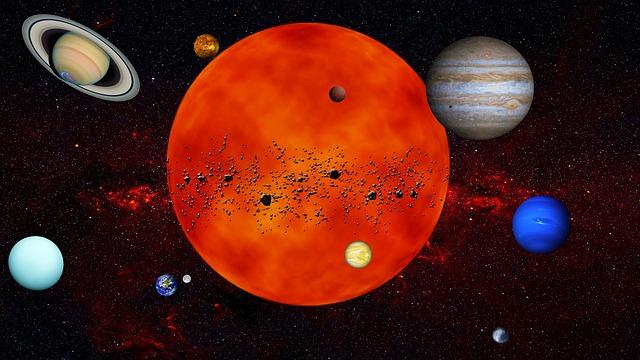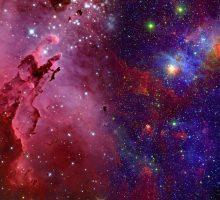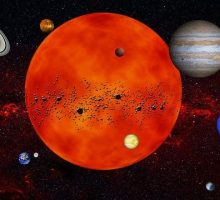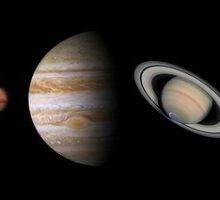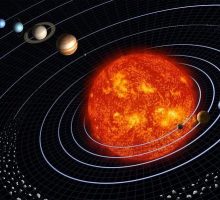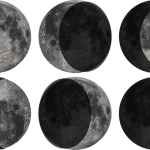- Introduction to our Solar System: A Brief Overview
- The Sun: Our Very Own Star
- The Planets: A Tour of the Solar System
- Terrestrial Planets: Earth, Mars, Venus and Mercury
- Gas Giants: Jupiter, Saturn, Uranus and Neptune
- Dwarf Planets: Pluto, Ceres and Eris
- Moons: The Fascinating Satellites of Our Solar System
- Asteroids, Comets and Meteoroids: Small Objects with Big Stories
- Formation of the Solar System: How it all Began
- Exoplanets: Discovering New Worlds Beyond Our Solar System
- The Search for Life in Our Solar System
- The Future of Space Exploration: What Lies Ahead for Our Solar System?
Introduction to our Solar System: A Brief Overview
Our Solar System is a mesmerizing and complex system that consists of a central star, the Sun, and all the objects that orbit around it. These objects include planets, dwarf planets, moons, asteroids, comets, and other celestial bodies. It is estimated that there are around 100 billion stars in our Milky Way galaxy, and each of these stars could potentially have their own solar system, making the universe an endless wonder to explore.
The Sun is the central object of our Solar System, and everything else orbits around it. It is a massive ball of hot gas, and its gravity is what keeps all the objects in the Solar System in their respective orbits. The Sun is the most important source of energy for all life on Earth, and without it, life would not be possible.
The eight planets in our Solar System are Mercury, Venus, Earth, Mars, Jupiter, Saturn, Uranus, and Neptune. These planets can be divided into two groups: the inner planets, which are Mercury, Venus, Earth, and Mars, and the outer planets, which are Jupiter, Saturn, Uranus, and Neptune. The inner planets are also known as the terrestrial planets because they are made mostly of rock and metal, while the outer planets are called gas giants because they are made mostly of gas and ice.
In addition to the planets, our Solar System also has dwarf planets such as Pluto, Ceres, and Eris. These small objects are similar to planets in that they orbit around the Sun, but they are not large enough to have cleared their orbits of debris.
Moons are also an important part of our Solar System. They are natural satellites that orbit around planets and dwarf planets. Some of the most well-known moons in our Solar System include Earth’s Moon, Jupiter’s Galilean moons, and Saturn’s Titan.
Asteroids, comets, and meteoroids are other important objects in our Solar System. Asteroids are small, rocky objects that orbit the Sun, while comets are icy objects that also orbit the Sun but have long tails of gas and dust. Meteoroids are small fragments of rock and metal that are the result of collisions between asteroids and other objects in space.
The Solar System formed around 4.6 billion years ago from a giant cloud of gas and dust. Over time, the gravity of the cloud caused it to collapse and form a disk. The Sun formed at the center of this disk, while the rest of the material in the disk began to clump together to form the planets, moons, asteroids, and other objects in the Solar System.
The Sun: Our Very Own Star
The Sun is the center of our Solar System and the most important source of energy for all life on Earth. It is a massive ball of hot gas that has been burning for more than 4.6 billion years, and it will continue to shine for billions of years to come. In this blog, we will explore the characteristics, importance, and mysteries of our very own star, the Sun.
Characteristics of the Sun
The Sun is a massive ball of hot gas, mostly composed of hydrogen and helium, with a small amount of other elements. It has a diameter of approximately 1.39 million kilometers, which is about 109 times larger than the diameter of Earth. The Sun’s surface temperature is around 5,500 degrees Celsius, and its core temperature is around 15 million degrees Celsius.
The Sun’s energy is produced through a process called nuclear fusion, which occurs at the core of the star. Nuclear fusion is the process of combining two atomic nuclei to form a heavier nucleus, releasing a tremendous amount of energy in the process. The energy generated by nuclear fusion is what keeps the Sun burning.
Importance of the Sun
The Sun is essential for life on Earth. It is the primary source of energy for all living organisms, providing light and heat that drive the planet’s weather patterns and the photosynthesis process in plants. The Sun’s energy also powers the water cycle, which is responsible for supplying fresh water to the Earth’s surface.
The Sun is also important for space exploration. It is the only star we can study up close, and scientists can use its light to learn more about the properties of other stars in the universe. Additionally, studying the Sun’s activity can help us better understand and predict space weather, which can have an impact on our communication and navigation systems.
Mysteries of the Sun
Although the Sun is our closest star, there is still much that scientists do not know about it. One of the biggest mysteries is the solar cycle, which is the periodic variation in the Sun’s activity, including the number of sunspots, solar flares, and other phenomena. The solar cycle lasts approximately 11 years, but its underlying mechanisms are still not fully understood.
Another mystery of the Sun is its corona, which is the outermost layer of the Sun’s atmosphere. The corona is much hotter than the surface of the Sun, which is counterintuitive since the further away you are from a heat source, the cooler it should be. Scientists are still working to understand why this is the case
The Planets: A Tour of the Solar System
Our Solar System consists of eight planets that orbit around the Sun. Each planet has its own unique characteristics and features that make them fascinating to study. In this blog, we will take a tour of the Solar System and explore the different planets and their characteristics.
Mercury
Mercury is the closest planet to the Sun and is also the smallest planet in our Solar System. It is a rocky planet, similar in size and composition to Earth’s Moon. It has a very thin atmosphere and experiences extreme temperature changes, ranging from -173 degrees Celsius at night to 427 degrees Celsius during the day.
Venus
Venus is the second planet from the Sun and is often called Earth’s sister planet due to their similar size and composition. However, Venus has a thick atmosphere made up of carbon dioxide, which creates a runaway greenhouse effect and makes it the hottest planet in our Solar System, with surface temperatures that can reach 460 degrees Celsius.
Earth
Earth is the third planet from the Sun and is the only known planet with liquid water on its surface. It has a protective atmosphere that helps regulate temperature and protect life from harmful solar radiation. It is the only planet known to support life and is home to a vast array of living organisms.
Mars
Mars is the fourth planet from the Sun and is known as the Red Planet due to its reddish appearance caused by iron oxide on its surface. It has a thin atmosphere and is a cold, dry planet with a temperature range of -87 degrees Celsius to -5 degrees Celsius. Mars has polar ice caps and is the focus of many space exploration missions.
Jupiter
Jupiter is the fifth planet from the Sun and is the largest planet in our Solar System. It is a gas giant, composed mostly of hydrogen and helium, and has a thick atmosphere that gives it a banded appearance. Jupiter has a strong magnetic field and is known for its numerous moons, including four large moons known as the Galilean moons.
Saturn
Saturn is the sixth planet from the Sun and is also a gas giant, with a similar composition to Jupiter. It is famous for its spectacular ring system, made up of ice and dust particles, which makes it one of the most recognizable planets in our Solar System. Saturn also has numerous moons, including Titan, the only moon in our Solar System with a dense atmosphere.
Uranus
Uranus is the seventh planet from the Sun and is an ice giant, composed mostly of water, ammonia, and methane ices. It is unique in our Solar System because its axis of rotation is tilted at an angle of 98 degrees, causing it to appear to roll on its side. Uranus also has a system of rings and numerous moons.
Neptune
Neptune is the eighth planet from the Sun and is also an ice giant, with a similar composition to Uranus. It has a dynamic atmosphere, with strong winds and storms, and is known for its Great Dark Spot, a large storm system similar to Jupiter’s Great Red Spot. Neptune has 14 known moons and a system of rings.
Terrestrial Planets: Earth, Mars, Venus, and Mercury
The terrestrial planets are the four innermost planets in our Solar System: Mercury, Venus, Earth, and Mars. They are called “terrestrial” because they are solid, rocky planets like Earth. In this blog, we will explore the characteristics and features of each of the terrestrial planets.
Mercury
Mercury is the smallest planet in our Solar System and the closest planet to the Sun. It has a diameter of 4,880 km and orbits the Sun in just 88 Earth days. Mercury has a heavily cratered surface, indicating that it has been bombarded by meteorites over its long history. Its surface is also covered in plains and ridges formed by volcanic activity. Mercury has a very thin atmosphere and no moons.
Venus
Venus is the second planet from the Sun and is often called Earth’s sister planet because of their similar size and composition. It has a diameter of 12,104 km and is the hottest planet in our Solar System, with surface temperatures that can reach up to 460 degrees Celsius. Venus has a thick atmosphere composed mainly of carbon dioxide, which creates a runaway greenhouse effect that traps heat and causes the planet’s high temperatures. Its surface is covered in volcanoes, mountains, and plains, and it has no moons.
Earth
Earth is the third planet from the Sun and the only known planet with liquid water on its surface. It has a diameter of 12,742 km and is the largest of the terrestrial planets. Earth has a protective atmosphere that helps regulate temperature and protect life from harmful solar radiation. Its surface is covered in diverse environments, including oceans, continents, and polar ice caps. Earth has one moon, which plays a crucial role in regulating the tides and stabilizing the planet’s rotation.
Mars
Mars is the fourth planet from the Sun and is often called the “Red Planet” because of its reddish appearance caused by iron oxide on its surface. It has a diameter of 6,779 km and is the second smallest of the terrestrial planets. Mars has a thin atmosphere composed mainly of carbon dioxide, with a surface pressure less than 1% of Earth’s. Its surface is covered in impact craters, volcanoes, canyons, and polar ice caps. Mars has two small moons, Phobos and Deimos.
Gas Giants: Jupiter, Saturn, Uranus, and Neptune
The Gas Giants are the four outermost planets in our Solar System: Jupiter, Saturn, Uranus, and Neptune. Unlike the terrestrial planets, they are not composed of solid rock but instead are made up of mostly hydrogen and helium gases. In this blog, we will explore the characteristics and features of each of the Gas Giants.
Jupiter
Jupiter is the largest planet in our Solar System, with a diameter of 139,822 km, more than 11 times the diameter of Earth. It is named after the Roman god Jupiter, the king of the gods. Jupiter has a thick atmosphere with colorful bands of clouds and the famous Great Red Spot, a giant storm that has been raging for over 300 years. Jupiter has 79 known moons, including the four largest known as the Galilean moons: Io, Europa, Ganymede, and Callisto.
Saturn
Saturn is the second-largest planet in our Solar System, with a diameter of 116,460 km, almost 9 times the diameter of Earth. It is named after the Roman god Saturn, the god of agriculture and time. Saturn is known for its iconic rings, made up of ice particles and rocks ranging in size from dust to large boulders. Saturn has a thick atmosphere with colorful bands of clouds and is the only planet in our Solar System with a density less than water. Saturn has 82 known moons, including the largest, Titan, which is larger than the planet Mercury.
Uranus
Uranus is the third-largest planet in our Solar System, with a diameter of 50,724 km, about 4 times the diameter of Earth. It is named after the Greek god of the sky, Uranus. Uranus is unique among the Gas Giants because it rotates on its side, with its poles pointed towards the Sun. Uranus has a thin atmosphere with faint bands of clouds and is composed mainly of hydrogen and helium gases with traces of methane. Uranus has 27 known moons, including the largest, Miranda, known for its bizarre, fragmented terrain.
Neptune
Neptune is the fourth-largest planet in our Solar System, with a diameter of 49,244 km, about 3.9 times the diameter of Earth. It is named after the Roman god of the sea, Neptune. Neptune has a thick atmosphere with colorful clouds and the fastest winds in the Solar System, reaching speeds of up to 2,400 kilometers per hour. Neptune is composed mainly of hydrogen and helium gases with traces of methane. Neptune has 14 known moons, including the largest, Triton, which is unique among the moons in our Solar System because it orbits in a direction opposite to Neptune’s rotation.
Dwarf Planets: Pluto, Ceres, and Eris
Dwarf planets are celestial bodies that orbit the Sun and have enough mass to form a sphere but are not massive enough to clear their orbits of other debris. In this blog, we will explore three of the known dwarf planets in our Solar System: Pluto, Ceres, and Eris.
Pluto
Pluto was considered the ninth planet in our Solar System until 2006 when it was reclassified as a dwarf planet. It is located in the Kuiper Belt, a region of the Solar System beyond Neptune that is home to many small icy objects. Pluto is a small, rocky, and icy world with a diameter of 2,377 km, less than half the size of Earth’s moon. It has a thin atmosphere made up of nitrogen, methane, and carbon monoxide, and its surface is covered in frozen nitrogen, methane, and carbon monoxide, giving it a reddish-brown color. Pluto has five known moons, the largest of which, Charon, is about half the size of Pluto.
Ceres
Ceres is the largest object in the asteroid belt between Mars and Jupiter and was the first dwarf planet to be discovered. It has a diameter of 945 km, making it the smallest of the known dwarf planets. Ceres is composed mainly of rock and ice and has a thin atmosphere made up of water vapor. Its surface is covered in bright spots, which are thought to be deposits of salt or ice. Ceres has no known moons.
Eris
Eris is a dwarf planet located in the Kuiper Belt, beyond the orbit of Neptune. It was discovered in 2005 and is slightly larger than Pluto, with a diameter of 2,326 km. Eris is composed mainly of rock and ice and has a thin atmosphere made up of nitrogen and methane. Its surface is covered in frozen nitrogen and methane, giving it a reddish-brown color. Eris has one known moon, Dysnomia, which is about one-tenth its size.
Moons: The Fascinating Satellites of Our Solar System
Moons are natural satellites that orbit planets or dwarf planets in our Solar System. They come in a variety of sizes and compositions, and they play a critical role in shaping the worlds they orbit. In this blog, we will explore some of the most fascinating moons in our Solar System.
Titan
Titan is the largest moon of Saturn and the second-largest moon in our Solar System. It is unique because it has a thick atmosphere made up mostly of nitrogen, similar to Earth’s atmosphere. However, its atmosphere also contains methane, which gives it a hazy orange appearance. Titan’s surface is covered in icy mountains, lakes, and rivers of liquid methane and ethane. It is the only known place in the Solar System, other than Earth, with stable bodies of liquid on its surface. Scientists believe that Titan’s complex chemistry and potentially habitable environment make it a promising destination for future exploration.
Europa
Europa is one of Jupiter’s four largest moons and is believed to have a subsurface ocean of liquid water beneath its icy surface. The presence of water and heat sources on Europa make it one of the most promising places in our Solar System to search for extraterrestrial life. Europa’s surface is also covered in cracks and ridges that suggest tectonic activity, similar to Earth. Scientists have proposed several missions to Europa in the hopes of exploring its potential for hosting life.
Enceladus
Enceladus is a small, icy moon of Saturn that has a subsurface ocean of liquid water. It is unique because it has geysers that shoot water and other materials into space from its southern pole. The geysers suggest that Enceladus has hydrothermal activity, which could provide the necessary conditions for life to exist. Scientists have proposed several missions to Enceladus to study its geysers and potential for hosting life.
Ganymede
Ganymede is the largest moon of Jupiter and the only moon in our Solar System with its own magnetic field. It has a complex geology, with evidence of tectonic activity and a mix of icy and rocky terrain. Ganymede is also believed to have a subsurface ocean of liquid water, making it another potential target for future exploration.
Asteroids, Comets and Meteoroids: Small Objects with Big Stories
The Solar System is not only composed of planets, but also of many small objects that orbit the Sun. These objects include asteroids, comets, and meteoroids. In this blog, we will explore what these small objects are, where they come from, and how they have shaped the history of our Solar System.
Asteroids
Asteroids are rocky, airless objects that orbit the Sun. They are remnants from the formation of the Solar System, and they range in size from small rocks to objects hundreds of kilometers in diameter. Most asteroids are found in the asteroid belt between Mars and Jupiter, but some have orbits that take them closer to Earth. In fact, some asteroids have collided with Earth in the past, causing significant damage.
Comets
Comets are icy objects that also orbit the Sun. They are composed of ice, dust, and rocky materials, and they have highly elliptical orbits that take them far from the Sun and then back again. When comets get close to the Sun, they heat up and release gas and dust, creating a glowing coma and a long tail. Comets are believed to be remnants from the formation of the Solar System, and their composition provides important insights into the early stages of the Solar System’s evolution.
Meteoroids
Meteoroids are small pieces of asteroids or comets that enter the Earth’s atmosphere. When they enter the atmosphere, they heat up and create a bright streak of light called a meteor or shooting star. Most meteoroids burn up completely in the Earth’s atmosphere, but some larger pieces may make it all the way to the surface and become meteorites.
Impact events
Asteroids and comets have collided with Earth in the past, causing significant damage and shaping the course of evolution. One of the most famous impact events is the Chicxulub impact, which occurred 66 million years ago and is believed to have caused the extinction of the dinosaurs. Impact events can also create large craters, such as the Barringer Crater in Arizona, which was formed by an impact around 50,000 years ago.
Formation of the Solar System: How it all Began
The Solar System is a fascinating place, full of mysteries and wonders. But how did it all begin? In this blog, we will explore the formation of the Solar System and the scientific theories that attempt to explain this incredible event.
The Nebular Hypothesis
The leading scientific theory for the formation of the Solar System is the Nebular Hypothesis. According to this theory, the Solar System began as a giant cloud of gas and dust called a nebula. This nebula was composed primarily of hydrogen and helium, with smaller amounts of heavier elements.
Over time, the nebula began to contract under the force of gravity. As it contracted, it spun faster and faster, flattening into a spinning disk. At the center of this disk, the pressure and temperature became so high that nuclear fusion began, igniting the Sun.
Planetary Formation
As the disk of gas and dust spun around the Sun, it began to cool and clump together into solid objects. These objects, known as planetesimals, collided and stuck together to form larger bodies. Eventually, the larger bodies became large enough to attract even more material, eventually forming the planets and other objects in the Solar System.
Terrestrial Planets vs. Gas Giants
The planets in the Solar System can be divided into two categories: terrestrial planets and gas giants. Terrestrial planets are smaller, denser, and rocky, while gas giants are larger, less dense, and composed primarily of gas and ice.
The inner planets, Mercury, Venus, Earth, and Mars, are terrestrial planets. They formed close to the Sun, where temperatures were too high for gases to condense into solid objects. The outer planets, Jupiter, Saturn, Uranus, and Neptune, are gas giants. They formed farther from the Sun, where temperatures were low enough for gases to condense into solid objects.
Exoplanets: Discovering New Worlds Beyond Our Solar System
For centuries, humans have looked up at the night sky and wondered if we are alone in the universe. With the discovery of exoplanets, or planets outside of our Solar System, we may be closer to answering that question than ever before. In this blog, we will explore the exciting field of exoplanet research and the methods scientists use to detect and study these distant worlds.
The Search for Exoplanets
The search for exoplanets began in the early 1990s with the discovery of the first confirmed exoplanet, 51 Pegasi b. Since then, thousands of exoplanets have been discovered using a variety of techniques.
One of the most common methods for detecting exoplanets is the transit method. This involves observing a star and looking for dips in its brightness as a planet passes in front of it, blocking some of the star’s light. Another method is the radial velocity method, which looks for wobbles in a star’s motion caused by the gravitational pull of an orbiting planet.
Other methods for detecting exoplanets include direct imaging, which involves taking pictures of the exoplanet, and the microlensing method, which uses the gravitational lensing effect to detect exoplanets.
Types of Exoplanets
Exoplanets come in a wide variety of sizes and compositions, ranging from rocky, Earth-like planets to gas giants many times the size of Jupiter. Some exoplanets even orbit in the habitable zone of their star, where temperatures are just right for liquid water to exist on their surface.
The discovery of exoplanets has also led to the discovery of new planetary systems with unusual configurations, such as planets orbiting binary stars or planets with highly eccentric orbits.
The Search for Life
One of the most exciting aspects of exoplanet research is the search for life beyond Earth. While no definitive evidence of life has yet been found, the discovery of exoplanets in the habitable zone of their star is a promising sign.
Scientists are currently developing new instruments and techniques to study the atmospheres of exoplanets and look for signs of life, such as the presence of oxygen, methane, or other biomarkers.
The Search for Life in Our Solar System
The question of whether we are alone in the universe has fascinated humans for centuries. While the search for life beyond Earth often focuses on exoplanets, there are also intriguing possibilities for finding life closer to home in our own Solar System. In this blog, we will explore the current state of the search for life in our Solar System and the places where we may be most likely to find it.
Mars
Mars is one of the most promising places to search for life in our Solar System. Evidence suggests that Mars may have had liquid water on its surface in the past, and there are signs of underground water and ice today. In addition, recent discoveries of methane in Mars’ atmosphere have raised the possibility of microbial life.
Several missions to Mars have searched for signs of life, including the Viking missions in the 1970s and the more recent Curiosity and Perseverance rovers. These missions have found evidence of organic molecules, which are the building blocks of life, but have not yet found definitive evidence of life itself.
Europa
Europa is one of Jupiter’s moons and is covered in a layer of ice. Beneath that ice is thought to be a vast ocean of liquid water, which could be a habitat for life. The Galileo spacecraft, which visited Jupiter in the 1990s, provided evidence of a subsurface ocean on Europa, and several upcoming missions are planned to study the moon in more detail.
Enceladus
Enceladus is one of Saturn’s moons and, like Europa, is thought to have a subsurface ocean. In addition, plumes of water vapor and ice have been detected erupting from cracks in Enceladus’ surface, providing a potential source of samples for future missions to study.
Titan
Titan is Saturn’s largest moon and is unique in that it has a thick atmosphere and liquid lakes and seas on its surface. While the lakes and seas are made of liquid methane and ethane, rather than water, they could potentially harbor life that has adapted to these extreme conditions.
The Future of Space Exploration
The exploration of space has been one of humanity’s greatest achievements, and our knowledge of our own Solar System has expanded greatly over the past century. From landing humans on the Moon to sending probes to the farthest reaches of our Solar System, we have made incredible strides in our understanding of the cosmos. But what lies ahead for the future of space exploration? In this blog, we will explore some of the exciting missions and possibilities that are on the horizon.
Return to the Moon
One of the most ambitious plans for future space exploration is the return of humans to the Moon. NASA’s Artemis program aims to land the first woman and next man on the Moon by 2024, with a sustainable presence on the lunar surface by the end of the decade. Private companies, such as SpaceX and Blue Origin, also have plans for lunar exploration and colonization.
Exploration of Mars
Mars has long been a target for exploration, and several upcoming missions are planned to study the Red Planet in more detail. NASA’s Perseverance rover, which landed on Mars in February 2021, will search for signs of past microbial life and prepare samples for eventual return to Earth. In addition, NASA’s Mars Sample Return mission, planned for the mid-2020s, will bring back samples of Martian rock and soil for detailed analysis.
Exploration of Europa and Enceladus
As we discussed in our previous blog on the search for life in our Solar System, Europa and Enceladus are two of the most promising targets for the search for extraterrestrial life. Several missions are planned to study these moons in more detail, including NASA’s Europa Clipper mission and the proposed Enceladus Life Finder mission.
Exploration of the Kuiper Belt
The Kuiper Belt is a region of the Solar System beyond Neptune that is home to thousands of icy objects, including dwarf planets like Pluto. In 2015, NASA’s New Horizons spacecraft flew by Pluto and provided the first close-up images of the dwarf planet. Now, NASA is considering a mission to explore more objects in the Kuiper Belt, including a potential flyby of the dwarf planet Eris.

